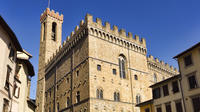Skip-the-Line Bargello Museum Ticket
Florence, Italy
Trip Type: Museum Tickets & Passes
Duration: Flexible
The Bargello palace was built in 1255 by the people of Florence as a symbol of their victory over the nobility, and was the site for the people's government and jurisdiction. The former fortress and arsenal now holds a superb collection of sculpture, one of the most important in all of Italy.
More About This Activity All Museum Tickets & Passes →
The Bargello palace was built in 1255 by the people of Florence as a symbol of their victory over the nobility, and was the site for the people's government and jurisdiction. The former fortress and arsenal now holds a superb collection of sculpture, one of the most important in all of Italy.As you enter the first room from the courtyard, you'll discover masterpieces by Michelangelo and on the ground floor, there are works of art by Cellini and Giambologna.
On the first floor, you will find the Salone del Consiglio (Council Hall), characterized by its high ceiling, once the tribunal hall. Here, you will see some of the finest works of Donatello; you can also visit the Ivory Room with the Carrand collection, 265 pieces that may be dated between the 5th and 17th century, including diptychs, ceramic tiles, reliquaries.
On the second floor, there are many glazed terracotta objects in two rooms, including the Busto di fanciullo (Baby's bust) by Andrea della Robbia. There is also an exhibition of Italian medals and an exquisite collection of small Renaissance bronzes. The Sala delle Armi contains fascinating medieval ivories, armory, and weapons.
On the first floor, you will find the Salone del Consiglio (Council Hall), characterized by its high ceiling, once the tribunal hall. Here, you will see some of the finest works of Donatello; you can also visit the Ivory Room with the Carrand collection, 265 pieces that may be dated between the 5th and 17th century, including diptychs, ceramic tiles, reliquaries.
On the second floor, there are many glazed terracotta objects in two rooms, including the Busto di fanciullo (Baby's bust) by Andrea della Robbia. There is also an exhibition of Italian medals and an exquisite collection of small Renaissance bronzes. The Sala delle Armi contains fascinating medieval ivories, armory, and weapons.
« Go Back

